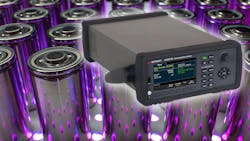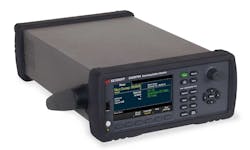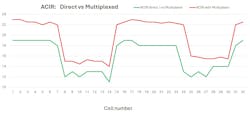Battery-Cell Testing Considerations for Incoming Inspection
What you'll learn:
While many articles have been written about cell testing in R&D labs or cell testing during manufacturing in the factory, let’s turn to the topic of cell testing for incoming inspection. This article covers testing strategies for handling this process. As an example, consider cells produced at a factory in China being delivered to a battery-powered tool manufacturer in the United States. What incoming inspection tests should be considered?
First and foremost, I recommend that these cell inspection tests should be pushed back onto the cell supplier, along with the cell purchaser’s requirements for measurement accuracy requirements and pass/fail limits.
Assuming the cell purchaser will perform the incoming inspection tests, the common electrical tests that should be considered are OCV, ACIR, DCIR, and possibly selective performance tests. This is based on general test strategy without specific conditions, given the context of how the cells will be used in their final application.
Common Tests for Incoming Inspection
OCV (Open Circuit Voltage)
This is the easiest to measure and most telling about the cell. If the SOC% is wrong because it’s not charged to the right capacity, it will be obvious if the OCV is out of the target incoming arrival specification. If the cells have excessive self-discharge, again, the OCV will be out of the target specification. If there’s complete cell failure, this will be revealed by the OCV. Figure 1 shows an example instrument to measure OCV.
ACIR (AC Internal Resistance)
This is a fast measurement and can often be done in conjunction with the OCV. For this reason, ACIR is low cost to implement because the equipment is inexpensive, the fixturing is the same as used in the OCV test, and the test time is short—all of which make ACIR a good choice. ACIR doesn’t tell you much specifically about the cell, but like OCV, if the ACIR is out of specification, something is wrong. This is like the doctor taking your temperature; it’s fast, easy, and can indicate something is wrong, but it’s not going to provide much of a diagnosis.
>>Download the PDF of this article
In this case of cell incoming inspection, an out-of-specification ACIR provides no understanding of the underlying cause of the problematic ACIR. Hence, ACIR is useful as a figure-of-merit. Check out this article for additional insights into ACIR.
DCIR (DC Internal Resistance)
This measurement is better than ACIR, as it does reveal something very specific about the cell. If the cells are being used in an application with high peak currents, then careful examination of DCIR would be critical. However, DCIR requires high current to make the measurement. When testing many cells simultaneously, sourcing many channels of high current can be expensive.
On the other hand, it's challenging to multiplex a single high-current source to multiple cells to make this measurement, so creating a setup that can quickly cycle through many cells is a real challenge. This technical article on Electronic Design provides further insight into DCIR.
Performance Tests
When the cell purchaser decides which vendor to use, the purchaser will run the sample cells through extensive performance testing to determine if this is the right cell for the application. These extensive performance tests will include tests such as load pattern testing (e.g., a drive cycle for an electric vehicle), cycle life, capacity, thermal behavior, resistance vs. SoC, and self-discharge. Figure 2 shows an example instrument to measure self-discharge.
These tests are expensive to run on an on-going basis. But a sample test from the incoming stream makes economic sense to ensure that drift (or worse, engineering changes) in the cell vendor’s process are small enough to keep the cells within the cell purchaser’s target requirements.
While the discussion so far has been about general cell characteristics, consideration should be given to spotlighting areas of specific quality for inspection. For example, if matching cells is important due to the design of the battery-management system (BMS), then OCV and capacity check measurement is critical. If you suspect that the vendor has quality problems with self-discharge, then this should be added to the inspection.
Note that these inspections could be done as incoming inspections or reported by the vendor as cell data, which I think is the preferable method.
Achieving Correlation with the Cell Vendor
When pushing cell testing back on to the cell vendor, the cell purchaser may be interested in performing sample audits on incoming cells to correlate back to the cell vendor’s measurements.
Suppliers frequently provide ACIR. ACIR, as a simple figure-of-merit type measurement, is a great way to compare your incoming ACIR inspection results versus the supplier’s measurements. By closely tracking ACIR, you can see if the cells are changing cell to cell, batch to batch, month to month, etc. You’ll need to establish quality limits that factor in measurement accuracy to determine how much ACIR drift is tolerable or if there’s a problem with drifting ACIR.
To compare your results to the supplier’s results, you must understand the conditions that the ACIR was made at the supplier, such as the equipment type and its accuracy. Only then can you compare your results to the supplier’s results made under different conditions.
If the same measurement is performed under the same conditions and both setups are calibrated, then you should get the same ACIR results within the error band of the measurement accuracies of the two instruments. However, that’s a lot of “ifs.”
Though the incoming inspection test setup will often be a basic automated or even manual test setup, in a cell manufacturing environment, this testing will be done with an automated setup. This means the two test setups are fundamentally different, even if using the same instrument.
Simply reading the specification from the ACIR meter’s datasheet will give a reasonable assessment of the system-level accuracy, However, it will not account for any part of the system that’s outside of the ACIR meter, like environmental conditions or wiring setup or multiplexing or contacting.
For example, research has shown that ACIR measurements made using a multiplexer cause a change in the ACIR test result as opposed to measuring ACIR by a direct connection to the cell.
Figure 3 compares ACIR measurements made using an ACIR meter directly connected one-by-one to each of 32 cells, to ACIR measured using the same ACIR meter connected to the cells through a 32-to-1 multiplexer. The direct measurement in green is lower than the multiplexed measurement in red, showing the impact of the multiplexer. This reveals that simply using the same instrument will not guarantee the same results due to influences of other factors in the test system.
Rather than rely on correlation between the supplier and the purchaser by using the same instrument, it would be more reliable to simply get a true metrology-based determination from the supplier about the real measurement accuracy. This would be based on the analysis of the equipment and its accuracy, the temperature/humidity variation and its effect on accuracy, and the setup of the wiring, multiplexing, and other factors that impact accuracy.
Going this route will result in a single system-level specification that covers all involved parameters, as well as provide a clear description of what performance to expect from the cell supplier’s data. This information enables you to better correlate the results from the supplier’s test setup with your setup, regardless of the differences.
Summary
When considering incoming inspection of purchased cells, a sound recommendation would be to start out with with “a little too much” inspection and roll back the inspection level as you determine if your supplier is reliable. Likewise, if these inspections show inbound quality is unacceptable, more inspection is warranted.
OCV and ACIR are two fast and inexpensive measurements to make, and 100% incoming inspection on OCV and ACIR should be considered as a minimum. With consistently good results, you can roll that back to a sampling approach.
If DCIR, capacity check, and self-discharge are critical parameters to the success of the cells in their final application, then it’s recommended to perform 100% inspection on those parameters as well, until you’re certain of supplier quality. Then move to sampling.
>>Download the PDF of this article
About the Author
Bob Zollo
Solution Architect for Battery Testing, Electronic Industrial Solutions Group
Bob Zollo is solution architect for battery testing for energy and automotive solutions in the Electronic Industrial Solutions Group of Keysight Technologies. Bob has been with Keysight since 1984 and holds a degree in electrical engineering from Stevens Institute of Technology, Hoboken, N.J. He can be contacted at [email protected].





